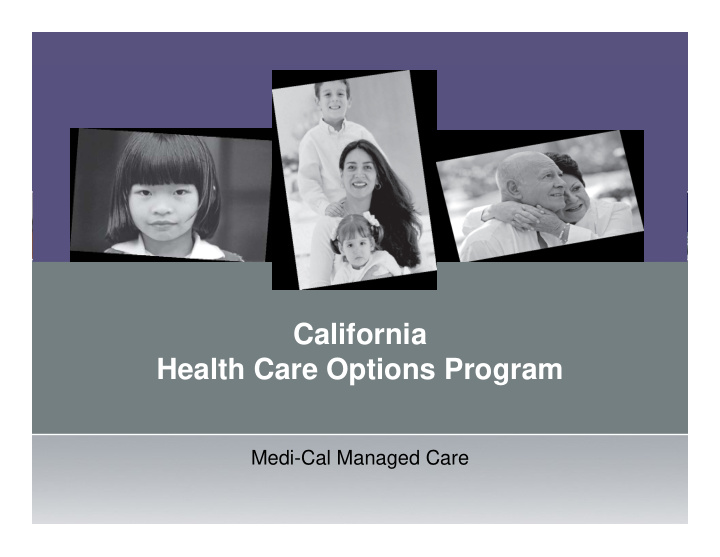



California Health Care Options Program Medi-Cal Managed Care
Our Program Objective � Health Care Options (HCO) Program objective - To ensure that all Medi-Cal applicants/beneficiaries are provided accurate, unbiased and current information regarding the health care options available in their geographical locations to enable them to make informed health care choices 2
Session Objectives � To understand the HCO program role in the Medi-Cal managed care system � To highlight the importance of consistent utilization of the HCO referral process � To foster unity and partnership with state and local community agencies � To highlight local HCO program resources � To understand recent enhancements in HCO program delivery 3
HCO Program Overview
HCO Program Overview What is the Health Care Options Program? � A state funded Medi-Cal managed care education and enrollment program � A program supervised by the California Department of Health Care Services (DHCS) � A program administered by MAXIMUS Inc., the California enrollment contractor ∘ Helping Government Serve the People in California since 1997 5
Managed Care Counties The HCO Field Operations Department provides customer-centric assistance at 101 sites throughout 13 California counties ∘ Alameda ∘ Contra Costa ∘ Fresno ∘ Kern ∘ Los Angeles ∘ Riverside ∘ Sacramento ∘ San Bernardino ∘ San Joaquin ∘ Santa Clara ∘ San Francisco ∘ Stanislaus ∘ Tulare 6
HCO Program Resources Field Operations Department � Enrollment Service Representatives (ESRs) provide education, enrollment, and customer service assistance on Medi-Cal Managed Care related issues � ESRs provide individuals with free, unbiased information in one-on-one settings or group sessions � ESRs are located in county social services sites, clinics, hospitals, health centers, and community-based health organizations 7
HCO Program Resources “cont.” Central Operations Department � HCO Call Center ∘ Toll-free language line assistance ∘ 13 threshold languages ∘ Monday – Friday from 8:00 a.m. – 5:00 p.m. � Mailhouse Department ∘ HCO informing materials available in 13 threshold languages ∘ User friendly format 8
California HCO Demographics
Medi-Cal Population In California, the HCO program serves an estimated 2.5 million Medi-Cal participants per year � The HCO program target population consists of two classifications of Medi-Cal participants: ∘ Mandatory ∘ Voluntary � Mandatory participants must join a Medi-Cal health plan if they receive CalWORKs benefits or Medi-Cal only without a “share of cost” � Voluntary participants may join a Medi-Cal health plan if they receive Medi-Cal benefits due to age, blindness, foster care or adoptive aid programs, disability, or SSI/SSP 10
The Default Population What is a “default?” – an automatic computer assignment into a health plan due to an applicant’s failure to make a choice � Mandatory participants who do not choose a Medi-Cal health plan within 30 days are automatically assigned a plan by the State � Between 2006 and 2008, 741,247 Californians or approximately one in every four Medi-Cal recipients did not make a health plan choice 40% Impact of Default 35% � Defaults can disrupt continuity 30% of health care services, 25% change provider/patient FY 2006 20% relationships, and cause FY 2007 15% FY 2008 unintended barriers to care 10% 5% 0% 1st Qtr 2nd Qtr 3rd Qtr 4th Qtr 11
HCO Referral Process
The HCO Referral Process Community agencies can partner with the HCO program by consistently referring all Medi-Cal managed care inquiries to your local HCO site by utilizing the HCO referral process � The HCO referral process is designed to partner with key community agencies to empower their Medi-Cal participants with the best tools and information to make an informed choice � Who Should Refer? ∘ County/Eligibility Staff ∘ Community-based Organizations ∘ Certified Application Assisters (CAAs) ∘ Providers ∘ Any agency serving the Medi-Cal population 13
Role of Community Partners The HCO program collaborates with recognized community partners to increase health plan choice rates and enhance enrollment satisfaction � Statewide, our community partners are the primary source for client referrals � ESRs currently provide approximately 14,000 educational presentations per month at community sites � The HCO program provides outreach and education services to key eligibility groups and hard to reach beneficiaries with onsite HCO services, participation in health fairs, and other outreach events 14
Utilizing the HCO Referral Process Why Should I Refer? � Some participants may not be aware they have been defaulted to a health plan until they encounter barriers in accessing their Medi-Cal benefits � HCO referral participation addresses the following concerns on behalf of your clients: ∘ Enrollment/Disenrollment ∘ Changing Providers ∘ Expedited Disenrollment Request ∘ Customer Service & Problem Resolution ∘ Referrals to Partnering Programs 15
HCO Referral Methods Community agencies can refer to the HCO program by a variety of methods � Referral processes can differ from county-to-county � Type of Referrals ∘ Verbal Referral Process ∘ Paper-based Referral Process ∘ Automated Referral Process 16
HCO Program Delivery System
HCO Program Delivery Highlights Enhanced System Delivery � Multi-channel approach ∘ Customer Service Portal (website) - Self-service options - Provider Information Network (PIN) - Plan information - Downloadable enrollment forms ∘ Telephone Interactive Voice Response (IVR) System with self-service options ∘ Telephone enrollment for new eligibles 18
HCO Website www.healthcareoptions.dhcs.ca.gov � How to navigate Medi-Cal managed care � Plan information system � County specific presentation schedules � Enrollment forms � Provider Information Network (PIN) � Information available in Spanish 19
What Questions Do You Have? � Open forum 20
Recommend
More recommend